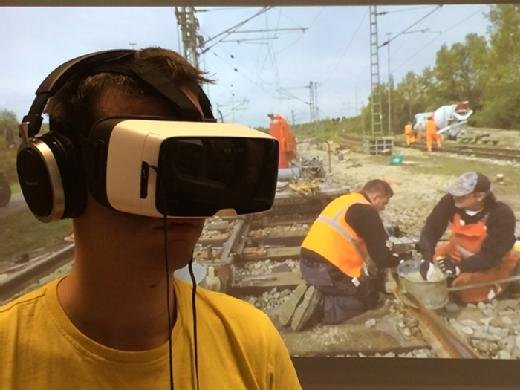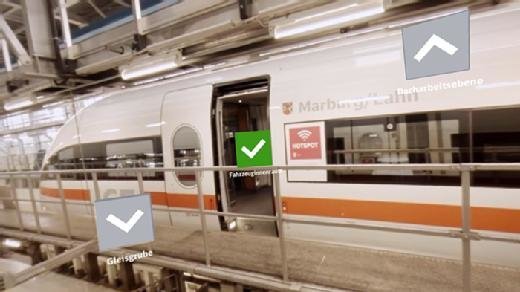
Gajus - Fotolia
German rail and transport group turns to virtual reality in war for talent
Deutsche Bahn claims to be the first company in Germany to use virtual reality as a recruitment tool
Deutsche Bahn, Germany’s former state-owned railway company, has turned to virtual reality (VR) to recruit employees in an increasingly competitive labour market.
The transport group, which provide bus, train and logistics services worldwide, needs to recruit between 7,000 and 8,000 people each year in Germany for the next four years to replace older employees on the verge of retiring.
The company is battling for recruits in a labour market that is undergoing major demographic changes, following a significant fall in the number of young people entering the German workforce.
Deutsche Bahn, which has a turnover of €40bn, manages Germany’s railway infrastructure, runs train and bus services overseas, including Arriva in the UK, and provides international logistics and delivery services. It employs 200,000 people in Germany and 100,000 overseas.
The company is investing in technology to give it an edge over rival employers as it seeks to recruit more apprentices, blue collar workers and academic specialists. Its projects include targeted recruitment campaigns on Facebook, a music streaming blog designed to appeal to school leavers and the development of an applicant tracking system that will make it easier for candidates to apply for jobs online.
In its latest move, the company is experimenting with three-dimensional virtual reality films that give potential employees the chance to “experience” different jobs on offer before they apply.
“The idea is to give people a really good insight of the jobs at Deutsche Bahn. We want applicants to get a close look over the shoulder of an electrician or a train driver. That is something that makes the application process very tangible and very satisfying. We can show how fascinating jobs are in the real world,” says Kerstin Wagner, head of talent acquisition at Deutsche Bahn Mobility Logistics.
Virtual reality recruitment drive
The project has its origins nearly four years ago, when Deutsche Bahn analysed its workforce data and realised that many of its key workers were reaching retirement age. At the same time, the company recognised that demographic changes meant the number of school leavers entering the German labour market was falling significantly.
The company responded by creating a 150-strong talent acquisition team to find new ways of attracting skilled staff to the company and training existing employees. It also set about raising the awareness of Deutsche Bahn as a potential employer through a marketing campaign with the message: “A job like no other.”
The company believes it is the first in Germany to use virtual reality technology to attract staff. It tested the idea at a recruitment event in October 2015, where it received an enthusiastic response, says Wagner, speaking ahead of a major HR technology conference.


The company is able to use the technology to give candidates the experience of driving into a train depot and inspecting the underside of one its flagship 320kph Intercity Express trains.
“We have had overwhelmingly positive feedback. The press coverage was great. We will definitely produce more insights and more films,” she tells Computer Weekly.
The company has plans to bring virtual reality headsets into schools to allow children to experience what it is like to work as a train engineer.
The technology could also help job candidates to feel less nervous while they are waiting for an interview, says Wagner.
The key to a successful virtual reality film is to work out precisely what you want to show and to brief the film crew carefully, but the films were not expensive or difficult to make, according to Wagner.
“We were working with a young film crew. It was low budget compared to the money we spend on employee branding. It was produced very quickly, in two days,” she says.
Wagner believes virtual reality will not only appeal to young people, but will also help older employees by showing them what their future workplace looks like and potentially introducing them to their future teams.
Musical blog to attract apprentices
In another innovative experiment, Deutsche Bahn has started a blog platform using the Tumblr blogging service and the music streaming service Spotify to encourage young people to apply for its apprenticeship programme.
The blog, dubbed “DB unplugged”, combines music streaming with regular blog posts from apprentices and trainees who write about their life both at work and outside work.
The company has found that young people are not interested in glossy marketing material, but they are attracted to music, and to the idea of reading authentic views from their peers, says Wagner.
“It really makes a difference. Since we launched we have had more than 60,000 people visit the platform. It means we are getting in touch with our target group and we’ve had very positive feedback,” she says.
Recruiting through social media
The company is also targeting potential recruits through its Facebook site, which has 140,000 followers. Wagner and her team have started working with Facebook to send targeted advertisements to potential candidates when vacancies arise.
The company recently launched a Facebook campaign to push out targeted job advertisements to three million potential candidates. The campaign led to a rush on Deutsche Bahn’s recruitment website, raising the number of clicks from 100,000 to half a million.
“If we are looking for IT people working in Frankfurt, and we want to target female IT people between 25 and 30 working within one square mile, I can push an advertisement to that group,” she says.
Tracking candidates
As competition for candidates intensifies, Deutsche Bahn plans to re-develop its applicant tracking system, which manages 200,000 job applications a year in Germany.
It is evaluating replacement technologies that will allow candidates from multiple countries to apply for jobs, either on the web or through mobile devices. The experience will make job applications much easier for candidates in the future, says Wagner.
“We want the experience to be very intuitive. The candidate should not use a lot of time to apply,” she says.
These initiatives have helped the company increase the number of people applying for jobs, reaching 12,000 applicants last year, says Wagner.
Lessons for other companies
Wagner advises other companies battling to recruit in a competitive employment market to think about the way they brand their company and their recruitment activities as a whole.
“Think of talent acquisition as a new role. Talent acquisition is not HR for beginners, it is a new profession,” she says.
Read more about HR technology
- Browser company Opera opts for slick internal IT as it competes with Apple and Google for skilled technologists.
- Cloud services company Workday is setting its sights on growth as it expands from cloud HR to finance, learning and analytics.
Kerstin Wagner is speaking at HR Tech World in Paris, which takes place on 27 and 28 October 2015.









